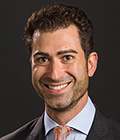- Is There a Doctor on the Plane? Management of Medical Emergencies at 30,000 Feet
- Tuesday, 1-2 p.m.
- McCormick Place West, W196c

Philip Rubin, M.D.
While traveling in 2014, anesthesiologist Philip Rubin, M.D., tried to assist a fellow passenger who suffered a heart attack on a domestic flight. He was surprised by the limited resources available on board a large passenger jet for a medical emergency and has since been working to improve the equipment available on planes in the U.S.
“My concern is that the contents of the medical emergency kit mandated by the FAA have not changed since 2004. There is no advanced airway equipment on board U.S.-based airliners,” Dr. Rubin said. Passenger flights with at least one flight attendant are required to have a defibrillator on board, as well as a BVM resuscitator and oral airways.
“I don’t think it would have changed the outcome in my situation, but I think there is very large room for improvement in the equipment that is available on board and how we handle more advanced medical emergencies,” he said.
Dr. Rubin and two other speakers will discuss the challenges medical professionals face in such situations Tuesday during “Is There a Doctor on the Plane? Management of Medical Emergencies at 30,000 Feet.”
“It was a life-changing experience because it opened my eyes in terms of understanding how these types of emergencies are handled in-flight, what equipment is available and, in general, the sequences of events to expect,” said Dr. Rubin, an Assistant Professor of Anesthesiology at Yale University School of Medicine.
He will recall his experience on the flight, and explain, along with two other speakers, what in-flight support is available, the logistics of diverting a flight in an emergency and the ethical concerns health professionals face during an in-flight medical emergency.
“I have become passionate about this issue because of my concern about the paucity of adequate medical equipment on board,” Dr. Rubin said. “Critics have said that commercial flights are not air ambulances. I respect that, but at least some advanced airway equipment should be accessible, given that it can take 30-40 minutes just to land the plane. In this era of modern medicine, we owe it to passengers to offer the same level of support that is available in even remote settings on the ground.
“I want people to understand that in Europe, such equipment is mandated. I think we can learn from their aviation system and improve upon ours.”
The other speakers will be Keith Ruskin, M.D., Professor of Anesthesia and Critical Care at the University of Chicago, and Paulo M. Alves, M.D., M.Sc., a cardiologist and the Global Medical Director for MedAire, Inc., Phoenix.
“Keith Ruskin is an expert in this field. He is an anesthesiologist and a pilot who has written extensively on this topic. He will talk about the physiologic changes that occur at 30,000 feet,” Dr. Rubin said. “Paulo Alves is going to shed light on how these medical kits were developed, what other types of resources are available in terms of communication with the ground and the logistics of handling these types of emergencies.”
Also discussed will be the Good Samaritan provision of the Aviation Medical Assistance Act, which protects medical professionals acting in an emergency.
“An in-flight medical emergency occurs once every 600 flights worldwide, which equates to 44,000 episodes worldwide annually,” Dr. Rubin said. “The numbers are only increasing because we are having longer flights and we have an aging population flying, so now is the time to institute some improvement in the system.”
Return to Archive Index